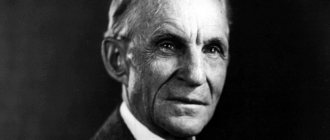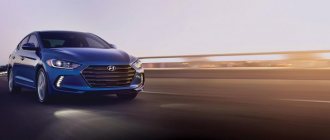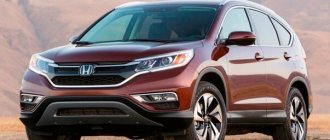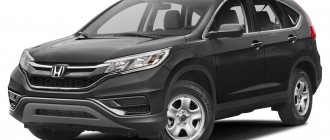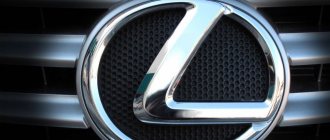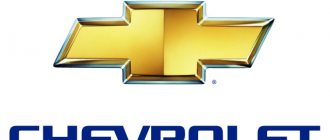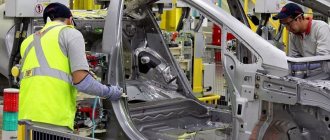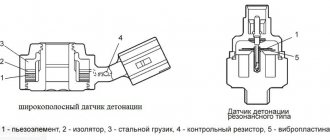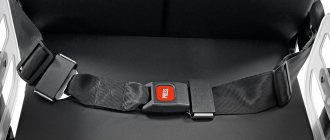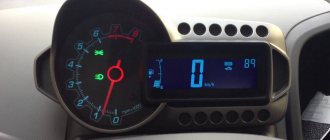Good day everyone! Today I would like to talk about original Honda oils . It's no secret that in most car stores you can buy both transmission and original Honda engine oils. Yes, you can count the range of original Honda oils on one hand, but let’s try to understand a little “where the legs come from.” So, what are they selling us under the beautiful name “original Honda oil”? The range of Honda motor oils is not that wide. All Honda engine oils are represented by just a few models: Japanese Honda Ultra LEO SN 0W20, Honda Ultra LTD SN 5W30 and MILD SN 10W30, Honda Ultra GOLD SN 5W40, as well as American and European Honda SN 0W20, 5W20, 5W30, 5W40, 10W30 . This is the entire range of motor oils that I have ever met, seen, touched and sold. Now let's get things done! Honda Ultra LEO SN 0W20 4l motor oil .
Canister Honda Ultra LEO SN 0W20
At the time of writing (and this is January 2020), the oil is supplied to the Russian market in a light blue metal 4-liter canister. The canister can be seen in the photo below. The average price is 2100-2500 rubles, which is quite acceptable. Original number (article) 08217-99974. Weight: 4.120 kg. Dimensions: 17 x 10 x 24 cm. The HONDA inscription and the company logo are printed on the front side of the canister. Just below are the full name ULTRA LEO MOTOR OIL, and even lower are the characteristics SN, SAE 0W20, API SN/ILSAC GF-5. The batch number and production date are printed on the top of the package.
Photo Honda Ultra LEO SN 0W20 4l
Let's figure out what these symbols mean. HONDA is the name of the oil, Ultra Leo Motor Oil is the model of the motor oil. 0W-20 - oil viscosity (0 - in normal condition, 20 - on a warm engine), API SN - engine oil class. Today, class SN is the latest class of motor oils, which is also the toughest. Oils that meet this class must fulfill a number of requirements. Firstly, they must be energy-saving. Secondly, have wear-resistant qualities. Thirdly, extend the life of the engine. API SN class was introduced at the end of 2010. And from now on, all Honda engine oils are produced taking into account these requirements. The ILSAC GF-5 specification is also common to all original Honda fluids. ILSAC GF-5 was also adopted at the end of 2010 and is currently the most recent. The requirements of ILSAC GF-5 are practically no different from the requirements for the API SN class, so we will not dwell on them in detail.
Soichiro Honda - creator of Honda cars
Download 250 success stories in Word format - Click hereMany people dream of success. I believe that success can only be achieved through repeated failure and self-reflection. In fact, success is only 1 percent of your work, and the remaining 99 percent is failure. Soichiro Honda
Where it all began.
Soichiro Honda was the first-born son of a very poor family living in the Japanese agricultural province of Hamamatsu. He was born on November 17, 1906, not far from Akio Morita, the founder of Sony. Morita was born into a wealthy family that owned tennis courts and other advantages, and Honda was the son of a poor blacksmith who repaired bicycles. This early involvement in sports vehicles largely determined Honda's future interest in motorcycles. His father's lessons, which taught him technical problem-solving skills, were an important factor in his early training. His family was so poor that five of the children died of starvation in infancy.
Soichiro was a poor student and often skipped school because he hated the formal learning process that school offered. He preferred the technique of experimentation and always learned better from his experiences and mistakes. He had always loved cars and mechanical devices and was literally mesmerized when he first saw a car as a child. Here is a quote from his biography:
Forgetting about everything in the world, I ran after the car... I was deeply excited... I think it was then, although I was very small, that the idea was born to me that someday I would make a car myself (Sanders, 1985).
Honda graduated from high school in 1922 and immediately went to Tokyo, where he apprenticed in an auto repair shop. After six years of apprenticeship, he raised money to open the first repair shop in his hometown (1928). In the same year, he received the first of his hundreds of patents, for the idea of replacing the wooden spokes of a car wheel with metal ones. This was Honda's first foray into the world of invention, and it paved the way for his future incredible technical innovations. Almost every one of them is a simple solution to a complex problem. Honda was an ordinary man, but his genius lay in his ability to find simple solutions to any problem that arose in connection with his products.
Becoming a businessman
Honda became famous thanks to the invention of the piston ring in 1938. He formed a new company that produced these rings in Tokyo. This continued during the war until his factory was damaged by bombing. The 1945 earthquake completely destroyed it. Honda was upset, sold everything and went to work part-time. His entry into the motorcycle market was completely accidental.
Once in 1946, Honda was faced with a problem - he did not have gasoline for his car, so he took one of the engines left behind by the American military, and attached it to his bicycle. This engine was filled with kerosene. Simple but elegant solutions to fundamental problems like this are Honda's usual style. Then he began making his own mopeds at the request of friends. Having completed a dozen such orders, as one might expect, Honda, eager for everything new, suggested that the market for such a car could be much larger. In 1948 he founded the Honda Motor Company to develop and manufacture mopeds.
Honda equipped its first moped with a 'D' engine (from dream). The Dream E model was launched in 1951, and by 1958, with the introduction of its Super Cub in the United States, Honda had become the largest moped manufacturer in Japan, leaving behind fifty competitors. The 'Super Cub' model had a unique footrest that was very popular with teenagers and women. Soon, thanks to the advertising campaign 'The best people ride a Honda motorcycle', this model revolutionized the industry. The $5 million advertising campaign was a hit in 1962 and succeeded in its goal of creating a biker image that helped popularize the motorcycle. From that moment on, the image of the Hell's Angels in a black leather jacket became a thing of the past. Market research confirmed that this 'Unisen' motorcycle was a technological breakthrough. Thanks to its effective image, low price and excellent workmanship, the market for this model has expanded to millions of units.
In 1961, Honda was producing 100,000 motorcycles a month, and by 1968, the millionth motorcycle was produced in the United States. By the mid-eighties, Honda held 60 percent of the world market, and by 1990 annual production reached three million units. This guy saw his childhood dream come true and was preparing to conquer new markets.
Honda entered the automobile market in 1970 with the Civic. He continued to equip his models with technical innovations, just as he did when he conquered the motorcycle market and was still not the favorite son of the Japanese engineering industry. He was a real rebel, especially when the oil crisis hit Japan in 1974 and Japanese manufacturers agreed to reduce production and raise prices. Only Honda refused and did the opposite, in the best traditions of Henry Ford. He did the unthinkable by rejecting the Galbraithian economic model that said production should decline. Honda doubled production and lowered prices more than Ford did fifty years ago. Honda, who had no idea about price elasticity, was right. Toyota's sales fell 40 percent; Honda sales rose 76 percent and continued to grow rapidly. By 1987, Honda had become the fastest growing company in the world.
Characteristics of behavior
In his youth, Soichiro Honda was frivolous and a ladies' man. He was known as the 'Playboy of Hamamatsu', a man who responded to any provocation. His love of fun and carefree behavior led to him once falling off a bridge with two geishas in his car. He saved them by throwing them out the window.
This extroverted personality was known as 'Mr. Thunder' among employees for his emotional outbursts in response to some stupidity of the employees. They loved Honda, but they were afraid of his anger.
The spirit of freedom inherent in many of Honda's designs confirms that he truly put a lot of thought into his creations. He had a free spirit and fought against tradition throughout his career. He refused to hire specialists who had received formal education for many years, because he felt that their dogmatic thinking would hinder the search for new things. His dreams of truth and vision of the world are reflected in Piersage's popular novel Zen Buddhism and the Art of Living by Motorcycle (1964), which uses the motorcycle as a metaphor for freedom. 'The motorcycle you create is what you identify with.' This expression describes the visionary innovator Soichiro Honda, who knew this truth better than anyone and was persistent in improving his personality and his products.
Honda was an extrovert who had an intuitive sense of business prospects and used analytical thinking to solve problems. He had the temperament of Prometheus, coupled with strong convictions and a stable life position. He was characterized by: impatience, rebellion, resistance to defeat, this man never gave up in the face of another problem. Honda was intolerant of conventional and traditional methods. He resisted the influence of world traditions on Honda Motors, which had its own principles. He blamed formal education for producing risk-averse specialists. He believed that academic education gave professionals a distrust of intuition and the use of new methods of solving problems. He admitted his mistakes, as seen in his speech at Michigan Tech University:
Looking back on my work, I feel that I have made nothing more than mistakes, a series of blunders, serious omissions. But I am also proud of my achievements. Although I made one mistake after another, my mistakes and failures never occurred for the same reasons.
Honda devoted much attention to experimental work and resisted any attempt to control him or his firm through the traditional caste system. He told the New York Times: 'Government officials always protect the public interest. But they always oppose you when you try to do something new.' This right-wing innovator drove the establishment crazy with his constant experimentation. He was against a hierarchical form of management, as is clear from his following quote: In general, people. work harder and more innovatively if they are not Forced, a completely different picture where they are strictly told what to do. What insight. Since then, psychologists have proven that he was right, and new leadership styles are approaching Honda's methodology.
Performance results
Honda did for motorcycles what Henry Ford did for cars. He took a dormant, stagnant market and made it active and dynamic. His persistent pursuit of the dream of a superior car was realized in elegant cars. Honda was a constant trendsetter in motorcycle design throughout the world from the mid-fifties to the early nineties. The Acura was the best-selling car worldwide in 1989, 1990, 1991 and 1992, according to Car and Track magazine. In 1991 they also created the extremely popular sports car, the NSEX. In 1993, they again won praise from J.D. Power - the Acura was again named the most popular model in the United States. Honda holds the status of the largest company formed after the Second World War in Japan.
In March 1988, Motor Trend magazine compiled a rating of the most popular cars in the world and the first three positions were occupied by cars - C-R-Ex, Civic, Prelude. Another flattering message came from Car and Driver magazine, which named the Accord one of the ten most popular cars in the United States. When the press reported that Honda was planning to refurbish it, the editor replied: "It's like doing a little modification to the Sistine Chapel or the Acropolis; we can't imagine a more stupid undertaking."
This recognition and success is the merit of a man who came from the impoverished environment of a small Japanese town with a modern mindset and a willingness to take risks in search of something new that appealed to the Americans. In Japan, a country where social loyalty is paramount, Honda was a true nonconformist. His nickname, 'Mr. Thunder' seemed so at odds with the small stature and incomprehensible behavior of a typical Japanese leader. He exemplifies tenacity, humility, pleasant manners, and the ability to embrace mistakes as an asset.
| Download 250 success stories in Word format - Click here |
Oil manufacturer Honda Ultra LEO SN 0W20
Now let's see what manufacturers and marketers say about this oil. As you noticed, I have not once mentioned the manufacturer of Honda Ultra Leo CH 0w20 oil. I dug through a lot of information before I got to the bottom of it. Most online stores selling such oil do not even think about the manufacturer. Who has what is written. I have come across a huge amount of heresy that Honda Ultra Leo oil is produced by Mobil, Honda, and Idemitsu. These are still the most adequate options, but far from the most important. There are even worse things to happen. Honda has never been involved in the production of HONDA oil! Manufacturers only select the most suitable oil for their cars and recommend them. Honda Ultra Leo 0W20 SN engine oil is produced by JX Nippon Oil & Energy Corporation , which in turn is the manufacturer of ENEOS oils. So we figured it out!
Childhood and family
Soichiro Honda was born on November 17, 1906 in the tiny Japanese village of Komyo, Shizuoka Prefecture. Currently, the native village of the founder of Honda Motor is absorbed by the city of Hamamatsu and is territorially part of it.
The parents of the future automotive genius were not rich people. Soichiro was their first surviving child; the other five children died in infancy. Father Gihei Honda had golden hands and worked as a blacksmith, mother Mika worked as a weaver. Soon after the birth of his son, Gihei opened a small bicycle repair shop. She did not bring in much income and Soichiro recalls that his childhood was “poor but calm.” Unlike his compatriot Akio Morita, the founder of Sony, Honda could not count on start-up capital. Akio and Soichiro were like the prince and the pauper from Mark Twain’s novel of the same name: the first was born into a wealthy family, the second spent his barefoot childhood on the banks of the Tenryu River. All the more interesting is the path to success of Soichiro Honda, who escaped from poverty on his own.
Soichiro's father taught him how to solve technical problems, and his grandfather took his grandson to a rice mill and sawmill. Soichiro developed an interest in mechanical devices as a child. At the age of 11, taking a bicycle from his father’s workshop, the boy rode 32 km to attend the air show of the American pilot Arthur Roy Smith. Soichiro could not buy an entrance ticket to the air show territory and climbed the tree from which he first watched the plane fly.
As part of a tour of Asia, pilot Arthur Smith demonstrated aerobatic maneuvers, which won the heart of the future founder of Honda Motor
The first meeting with the car also left a vivid memory. Seeing the car, Soichiro rushed after it, and then sniffed drops of engine oil left on the road. He really liked the new smell; the adult Honda commented on his “love at first sniff” as follows: “It was then, although I was still a boy, that the idea was born to create a car myself.”
Product description from the manufacturer
Now let's figure out what marketers say about this oil. Here is the verbatim description that I found on almost all sites: Honda Ultra Leo SN 0W20 is a high-quality synthetic all-season energy-saving motor oil for gasoline engines of Honda cars. It has outstanding fuel economy performance, excellent low temperature performance and high anti-oxidation properties for Japanese car engines. Recommended by the manufacturer for Honda cars since 2000. Filled in most new Honda cars.
In general, there are no complaints about the description. Everything is written quite truthfully, only written by marketers, and then borrowed by most stores. Judging by the description and SN class, everything should fit. And energy saving, and fuel economy, and “a long happy life of the engine.” Judging by the viscosity of the oil, the car should start easily and effortlessly even in cold weather. But what do the tests show?
Features of Soichiro Honda engines
- For a long time, the location of the engines under the hood was to the left of the gearbox when viewed from the interior; no one except Honda used this option for placing the engine in the engine-transmission compartment so thoroughly. For most engines, the crankshaft rotates counterclockwise. The exception is the motors of the K, L and R series, which began to be made in 2001 simultaneously with the replacement of the timing belt drive with a chain drive. At the same time, for all engines the direction of movement of the crankshaft is forward (along the axis of movement of the car). Why such design features were used remains a mystery.
- A design feature of Honda automobile engines is the presence of a unique system of dynamic variable valve timing VTEC (VTEC), which automatically changes the timing and stroke of the valves, adapting to various operating modes. The system is very effective in controlling the process of filling the combustion chambers with a mixture of fuel and air, taking into account atmospheric pressure. Many automakers tried to create a similar system, but Honda came up with a simpler, cheaper, and better one. What does the VTEC system provide? First it provides:
- economical operating mode when operating at low crankshaft speeds;
- maximum torque at medium speeds;
- maximum power at the highest speeds;
- allows you to shoot more than 100 hp. from one cube without turbocharging.
VTEC is implemented with a variety of options and they all have their own differences. In the very beginning, VTEC was used to increase engine power. Subsequently, the developers achieved the appearance of “economical” VTEC, then the so-called “three-stage” VTEC, and, finally, “intelligent” VTEC. The VTEC design turned out to be so perfect that all attempts up to the present day by other automakers to create something similar have not been realized due to poor reliability and high cost of development.
With the advent of VTEC, Honda was in no hurry to equip the engines of all the company’s cars with it. For a long time, engines of the same model were produced without and with the VTEC system. This forces you to carefully study the parts catalog to avoid confusion when purchasing spare parts. Over time, the concept was changed and for more than 10 years the latest version of VTEC (i-VTEC) has been installed as standard on all engines. Due to this, Honda engines combine all the maximum performance in terms of speed, reliability and efficiency.
Another feature of Honda engines is that they maintain reliability when operating at high speeds. The nimble Honda engines perfectly accept high speeds (from 4500 and above) and maximum loads, which is contraindicated for other engines. Cars receive maximum acceleration and maneuverability. You need to know that when operating Honda engines, maintenance should be carried out more often.
Physico-chemical test of Honda Ultra LEO SN 0W20 oil.
The tests were carried out by the independent laboratory "CHIMMOTOLOGY". Below are the relevant numbers.
1. Density of the oil product at 20C, kg/m3: 840 2. Kinematic viscosity of the oil product at 40C, cSt: 39.59 3. Kinematic viscosity of the oil product at 100C, cSt: 7.62 4. Apparent (dynamic) viscosity, determined on a cold simulator scroll (CCS), at -30C, mPa*s (cP): 3651 5. Base number, mg KOH/g: 6.49 6. Sulfate ash content, %: 0.87 7. Mass fraction of phosphorus, %: 0.053 8 Flash point of petroleum product in an open crucible, C: 225
I would like to draw your attention to just a few parameters from this table. Density and viscosity are clear parameters and I think it’s not worth explaining what they mean. Flash point is the temperature at which an oil ignites. But the most interesting parameters are ash content and phosphorus content. These are the values that should be as low as possible. In this particular case, 0.87% and 0.053% are very much within normal limits. If these indicators are higher, then harmful deposits will begin to form in the oil, which will “kill” the engine over time. But the alkaline number of 6.49 mg KOH/g is a little low. This parameter means that the oil contains additives that neutralize various acids, harmful formations, etc. But we must remember that the oil was developed for the Japanese market, and there gasoline is much higher quality than our Russian one, so the alkaline number should be within 8-9 units. This is not critical, of course, but it is still worth paying attention to.
And for skeptics, I am also attaching to the text the original laboratory tests of Honda Ultra Leo SN 0W20 oil. Please note that the examination was carried out by an independent laboratory, certified by a seal and signature. I want to say that there is no point in them overestimating or underestimating the real quality of the oil. And the most interesting thing is that there is also a declaration of product conformity. The original was not found, but there is a scan of good quality.
Tokai Seiki Heavy Industry Research Company: 1937-1945
In the first half of the 30s, Japan did not produce cars (the first production Toyota passenger car would roll off the assembly line in 1936); cars were imported from Europe and spare parts for them were expensive.
Together with his friend Shichiro Kato, Honda decided to start producing spare parts and in 1937 founded the company Tokai Seiki Heavy Industries (TSHI for short).
During the day, Honda runs an auto repair shop and at night he works on inventions. Another innovative discovery is the piston ring (a metal part that fits onto the engine piston). However, a high-quality prototype cannot be obtained: the created rings were inelastic.
The lack of specialized education had an effect, and Honda entered the correspondence department of the department of high-tech equipment at the College of Technology in Hamamatsu. Like a sponge, he absorbs knowledge by attending lectures by Professor Takashi Tashiro, and after 9 months he receives a prototype of satisfactory quality. Having launched high-tech mass production of piston rings, Honda abandoned education. In 1938, a savvy Japanese man received a patent for his invention. Before the war, Honda officially patented 50 developments.
at work at the research company Tokai Seiki Heavy Industry (TSHI)
In 1939, Honda delegated the management of the Art Shokai branch to his student Sueo Kawashima, and devoted himself to TSHI. The company already employs 2,000 people, and the main buyer of piston rings is becoming.
Honda cars in which it is recommended to use Honda Ultra Leo SN 0W20 oils
Here is a list of Honda cars in which the manufacturer recommends using Honda Ultra Leo SN 0W20 engine oil . If your car is not on the list and you doubt whether such oil is suitable, then it is better to look at these data in the owner’s manual or just call us at 600-042!
| Model | Body | Years of manufacture | Engine | Drive unit | Replacement volume | Viscosity | Class | |
| Accord | CL7 | 02.10-03.12 | K20A | 2.0 | 2WD A/T | 4.4 | 0W20 | SL/GF-3 |
| Accord | CL8 | 02.10-03.12 | K20A | 2.0 | 4WD | 4.4 | 0W20 | SL/GF-3 |
| Accord Wagon | CM2 | 02.11- | K24A | 2.4 | 2WD 24E | 4.2 | 0W20 | SM/GF-4 |
| Accord Wagon | CM3 | 02.11- | K24A | 2.4 | 4WD 24E | 4.2 | 0W20 | SM/GF-4 |
| Airwave | GJ1 | 05.04- | L15A | 1.5 | 2WD Multimatic | 3.6 | 0W20 | SM/GF-4 |
| Airwave | GJ2 | 05.04- | L15A | 1.5 | 4WD Multimatic | 3.6 | 0W20 | SM/GF-4 |
| Civic | EU1 | 00.09-03.08 | D15B | 1.5 | 2WD 4A/T | 3.3 | 0W20 | SM/GF-4 |
| Civic | EU1 | 00.09-03.08 | D15B | 1.5 | 2WD Multimatic | 3.3 | 0W20 | SM/GF-4 |
| Civic | EU2 | 00.09-03.08 | D15B | 1.5 | 4WD | 3.3 | 0W20 | SM/GF-4 |
| Civic | EU3 | 00.09-05.08 | D17A | 1.7 | 2WD Multimatic | 3.2 | 0W20 | SM/GF-4 |
| Civic | EU3 | 03.09-05.08 | D17A | 1.7 | 2WD M/T | 3.2 | 0W20 | SM/GF-4 |
| Civic | EU4 | 00.09-05.08 | D17A | 1.7 | 4WD | 3.2 | 0W20 | SM/GF-4 |
| Civic Hybrid | ES9 | 01.12- | LDA | 1.3 | 2WD | 3.2 | 0W20 | SM/GF-4 |
| Civic Ferio | ES1 | 00.09- | D15B | 1.5 | 2WD M/T | 3.3 | 0W20 | SM/GF-4 |
| Civic Ferio | ES1 | 00.09- | D15B | 1.5 | 2WD A/T | 3.3 | 0W20 | SM/GF-4 |
| Civic Ferio | ES1 | 00.09-03.08 | D15B | 1.5 | 2WD Multimatic | 3.3 | 0W20 | SM/GF-4 |
| Civic Ferio | ES2 | 00.09- | D15B | 1.5 | 4WD M/T | 3.3 | 0W20 | SM/GF-4 |
| Civic Ferio | ES2 | 00.09- | D15B | 1.5 | 4WD A/T | 3.3 | 0W20 | SM/GF-4 |
| Civic Ferio | ES3 | 00.09- | D17A | 1.7 | 2WD M/T | 3.2 | 0W20 | SM/GF-4 |
| Civic Ferio | ES3 | 00.09- | D17A | 1.7 | 2WD Multimatic | 3.2 | 0W20 | SM/GF-4 |
| Civic Ferio | ET2 | 03.09- | D17A | 1.7 | 4WD A/T | 3.2 | 0W20 | SM/GF-4 |
| CR-V | RD4 | 01.09-04.08 | K20A | 2.0 | 2WD | 4.4 | 0W20 | SM/GF-4 |
| CR-V | RD5 | 01.09-04.08 | K20A | 2.0 | 4WD M/T | 4.4 | 0W20 | SM/GF-4 |
| CR-V | RD5 | 01.09-04.08 | K20A | 2.0 | 4WD A/T | 4.4 | 0W20 | SM/GF-4 |
| CR-V | RD6 | 04.09- | K24A | 2.4 | 2WD | 4.2 | 0W20 | SM/GF-4 |
| CR-V | RD7 | 04.09- | K24A | 2.4 | 4WD 5A/T | 4.4 | 0W20 | SM/GF-4 |
| Edix | BE1 | 04.07- | D17A | 1.7 | 2WD | 3.2 | 0W20 | SM/GF-4 |
| Edix | BE2 | 04.07- | D17A | 1.7 | 4WD | 3.2 | 0W20 | SM/GF-4 |
| Edix | BE3 | 04.07- | K20A | 2.0 | 2WD | 4.4 | 0W20 | SM/GF-4 |
| Edix | BE4 | 04.07- | K20A | 2.0 | 4WD | 4.4 | 0W20 | SM/GF-4 |
| Element | YH2 | 03.04- | K24A | 2.4 | 4WD | 4.2 | 0W20 | SM/GF-4 |
| Elysion | RR1 | 04.05- | K24A | 2.4 | 2WD | 4.2 | 0W20 | SM/GF-4 |
| Elysion | RR2 | 04.05- | K24A | 2.4 | 4WD | 4.2 | 0W20 | SM/GF-4 |
| Elysion | RR3 | 04.05- | H30A | 3.0 | 2WD | 4.3 | 0W20 | SM/GF-4 |
| Elysion | RR4 | 04.05- | H30A | 3.0 | 4WD | 4.3 | 0W20 | SM/GF-4 |
| Fit | GD1 | 01.06- | L13A | 1.3 | 2WD | 3.6 | 0W20 | SM/GF-4 |
| Fit | GD2 | 01.06- | L13A | 1.3 | 4WD | 3.6 | 0W20 | SM/GF-4 |
| Fit | GD3 | 04.06- | L15A | 1.5 | 2WD M/T | 3.6 | 0W20 | SM/GF-4 |
| Fit | GD3 | 02.09- | L15A | 1.5 | 2WD Multimatic | 3.6 | 0W20 | SM/GF-4 |
| Fit | GD4 | 02.09- | L15A | 1.5 | 4WD | 3.6 | 0W20 | SM/GF-4 |
| Fit Aria | GD6 | 02.12- | L13A | 1.3 | 2WD | 3.6 | 0W20 | SM/GF-4 |
| Fit Aria | GD7 | 02.12- | L13A | 1.3 | 4WD | 3.6 | 0W20 | SM/GF-4 |
| Fit Aria | GD8 | 02.12- | L15A | 1.5 | 2WD | 3.6 | 0W20 | SM/GF-4 |
| Fit Aria | GD9 | 02.12- | L15A | 1.5 | 4WD | 3.6 | 0W20 | SM/GF-4 |
| Insight | ZE1 | 99.11- | ESA | 1.0 | M/T | 2.5 | 0W20 | SM/GF-4 |
| Insight | ZE1 | 99.11- | ESA | 1.0 | Multimatic | 2.5 | 0W20 | SM/GF-4 |
| Inspire | UC1 | 03.06- | J30A | 3.0 | 5A/T | 4.4 | 0W20 | SM/GF-4 |
War period: 1941-1945
On December 7, 1941, Japan entered World War II. The production capacity of Tokai Seiki Heavy Industry is taken under control by the Ministry of Defense: the plant processes parts for warships and aircraft and produces ammunition.
In 1942, 40% of the shares of TSHI were transferred to Toyota Motor, Soichiro was removed from the post of director, and now he is the senior manager of the enterprise. Japanese newspapers praise the “industrial hero”: by order of the Ministry of Defense, Honda developed equipment for cutting airplane propellers.
The TSHI factory was heavily damaged by bombing, and the 1945 earthquake finally destroyed it. By the end of the war, Honda sells the remains of the company to Toyota for 450,000 yen, and withdraws from business for a year. For 10,000 yen, he buys a tank of alcohol, treats his friends to homemade whiskey and enjoys his vacation.
